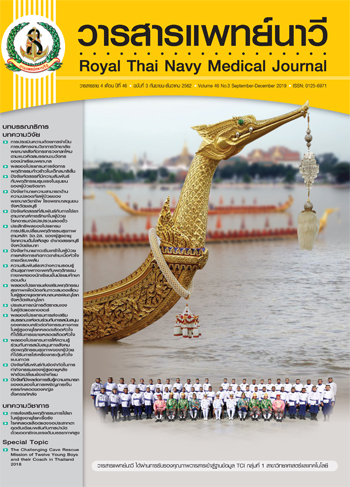ผลของโปรแกรมการส่งเสริมสมรรถนะแห่งตนร่วมกับการสนับสนุนของครอบครัวต่อกิจกรรมทางกายในผู้สูงอายุโรคหลอดเลือดหัวใจที่ได้รับการขยายหลอดเลือดหัวใจ
Main Article Content
บทคัดย่อ
การวิจัยครั้งนี้เป็นการวิจัยกึ่งทดลอง มีวัตถุประสงค์เพื่อศึกษาผลของโปรแกรมการส่งเสริมสมรรถนะแห่งตนร่วมกับการสนับสนุนของครอบครัวต่อกิจกรรมทางกายในผู้สูงอายุโรคหลอดเลือดหัวใจที่ได้รับการขยายหลอดเลือดหัวใจ กลุ่มตัวอย่าง คือ ผู้สูงอายุโรคหลอดเลือดหัวใจอายุ 60 ปีขึ้นไป ได้รับการรักษาด้วยการขยายหลอดเลือดหัวใจเป็นครั้งแรก ที่มารับบริการที่หอผู้ป่วยวิกฤติโรคหัวใจ โรงพยาบาลสมเด็จพระปิ่นเกล้า และหอผู้ป่วยหลังทำหัตถการหัวใจ โรงพยาบาลรามาธิบดี จำนวน 44 คน คัดเลือกกลุ่มตัวอย่างแบบเฉพาะเจาะจง แบ่งเป็นกลุ่มทดลองและกลุ่มควบคุม กลุ่มละ 22 คน กลุ่มทดลองได้รับโปรแกรมการส่งเสริมสมรรถนะแห่งตนร่วมกับการสนับสนุนของครอบครัว กลุ่มควบคุมได้รับการพยาบาลตามปกติเป็นระยะเวลา 5 สัปดาห์ โดยจัดให้ทั้งสองกลุ่มมีความเท่าเทียมกันในเรื่องเพศ อายุ ระดับการศึกษา และตำแหน่งที่ใส่สายสวนขยายหลอดเลือดหัวใจ เครื่องมือที่ใช้ในการดำเนินการทดลอง คือ โปรแกรมการส่งเสริมสมรรถนะแห่งตนร่วมกับการสนับสนุนของครอบครัว เครื่องมือที่ใช้ในการเก็บรวบรวมข้อมูล คือ แบบสัมภาษณ์ข้อมูลส่วนบุคคล และแบบสัมภาษณ์กิจกรรมทางกายในผู้สูงอายุ วิเคราะห์ข้อมูลโดยใช้ค่าความถี่ ร้อยละ ค่าเฉลี่ย ส่วนเบี่ยงเบนมาตรฐาน และสถิติการทดสอบที
ผลการวิจัย พบว่า คะแนนเฉลี่ยกิจกรรมทางกายของกลุ่มทดลองสูงกว่ากลุ่มควบคุม อย่างมีนัยสำคัญทางสถิติที่ระดับ .05 ผลการศึกษาชี้ให้เห็นว่า โปรแกรมการส่งเสริมสมรรถนะแห่งตนร่วมกับการสนับสนุนของครอบครัว สามารถช่วยให้ผู้สูงอายุโรคหลอดเลือดหัวใจที่ได้รับการขยายหลอดเลือดหัวใจมีความมั่นใจและสามารถปฏิบัติกิจกรรมทางกายภายหลังได้รับการขยายหลอดเลือดหัวใจมากขึ้น ดังนั้นควรนำโปรแกรมนี้ไปใช้ในการดูแลผู้สูงอายุโรคหลอดเลือดหัวใจที่ได้รับการขยายหลอดเลือดหัวใจ เพื่อลดความเสี่ยงการเกิดโรคหลอดเลือดหัวใจตีบซ้ำ
Article Details

อนุญาตภายใต้เงื่อนไข Creative Commons Attribution-NonCommercial-NoDerivatives 4.0 International License.
เอกสารอ้างอิง
World Health Organization. Global Physical Activity Questionnaire: analysis guide. [Internet]. [cited 2017 December 30 ]. Available from: https://www.who.int/mediacentre/ factsheets/fs317/en.
American Heart Association. Heart disease and stroke statistics – 2014 update. A Report From the American Heart Association Calculation 2014;129(3):399-410.
Karnjanapiboonwong A. Annual epidemiological surveillance report 2015. [Internet]. [cited 2017 December 28 ]. Available from: https://www.Boe.moph.go.th. (in Thai).
Sanprasan P, Wattradul D, Suthipong N. Discharge planning of patients treated with percutaneous coronary intervention (PCI): perspective of elderly patients with ischemic heart disease and caregivers. Thai Journal of Cardio-Thoracic Nursing 2017;28(1):142-53. (in Thai).
Hoondee O. The effect of using self-care program with behavior in patients undergoing percutaneous coronary intervention. Journal of the Medical Department 2016;41(4):118-26. (in Thai).
Tamruangit Y, Therawiwat M, Tunsakul S, Imamee N, Chantadansuwan T. A self-efficacy program on nutritional diet of coronary heart disease patients receiving percutaneous coronary intervention at central chest institute, Thailand. Journal of the Medical Department 2017;42(5):53-61. (in Thai).
Thanaphatsorn N, Howteerakul N, Sujirarat D, Suwannapong N, Kehasukcharorn W. Incidence and factors associated with instent restenosis in coronary heart disease patients at chest disease institute Nonthaburi Province (RSU National Research Conference 2015). [Internet]. [cited 2017 December 31]. Available from: https://www.mahidol.ac.th. (in Thai).
American College of Sports Medicine. ACSM’s guidelines for exercise testing and prescription. Philadelphia: Lippincotte William & Wilkins; 2010.
Kim C, Choi HE, Kim BO, Lim HM. Impact of exercise-based cardiac rehabilitation on in-stent restenosis with different generations of drug eluting stent. Ann Rehabil Med 2012;36(2):254–61.
World Health Organization. Global recommendation on physical activity for health. [Internet]. [cited 2018 March 8 ]. Available from: https://www.apps.who.int.
Allison TG. Changing medical culture to promote physical activity in secondary prevention of coronary artery disease. Eur Heart J 2013;34(42):3245-7.
Uysal H, Ozcan S. The effect of individual education on patient’s physical activity capacity after myocardial infraction. Int J Nurs Pract 2015;21(1):18-28.
Milanović Z, Pantelić S, Trajković N, Sporiš G, Kostić R, James N. Age-related decrease in physical activity and functional fitness among elderly men and women. Clin Interv Aging 2013;8:549-56.
Bandura A. Self-efficacy: the exercise of control. New York: W.H. Freeman And Company; 1997.
Slovinec D'Angelo ME, Pelletier LG, Reid RD, Huta V. The roles of self-efficacy and motivation in the prediction of short-and long-term adherence to exercise among patients with coronary heart disease. Health Psychology 2014;33(11):1344-53.
McAuley E, Mullen SP, Szabo AN, White SM, Wójcicki TR, Mailey EL. Self-regulatory processes and exercise adherence in older adults: executive function and self-efficacy effects. Am J Prev Med 2011;41(3):284-90.
Kanchanakijsakul C. Family participation in supporting drug use for Thai elderly with chronic diseases. Journal of Health Science 2016;25(2):192-203. (in Thai).
Wright LM, Leahey M. Nursing and families: a guide to family assessment and intervention. Philadelphia: F.A. Davis; 2009.
Adams GA, King LA, King DW. Relationships of job and family involvement, family social support, and work–family conflict with job and life satisfaction. Journal of Applied Psychology 1996;81(4):411-20.
Won MH, Son YJ. Perceived social support and physical activity among patient with coronary artery disease. West J Nurs Res 2017;39(12):1606-23.
Kähkönen O, Kankkunen P, Miettinen H, Lamidi ML, Saaranen T. Perceived social support following percutaneouse coronary intervention is a crucial in patients coronary heart disease. J Clin Nurs 2017;26(9-10):1264-80.
Maddison R, Pfaeffli L, Stewart R, Kerr A, Jiang Y, Rawstorn J, et al. The heart mobile phone trial: the partial mediating effects of self-efficacy on physical activity among cardiac patients. Front Public Health 2014 May 27;2:56. doi: 10.3389/fpubh.2014.00056.
Potamamanpong P, Kritpracha C, Chinnawong T. The effect of self-efficacy integration with family support program on behaviors to prevent heart attack recurrence in patients with acute myocardial infarction after revascularization. Songklanagarind Journal of Nursing 2015;35:49-60. (in Thai).
Burns N, Grove SK. The practice of nursing research: appraisal, synthesis and generation of evidence. 6th ed. St. Louis, MO: Elsevier Saunders; 2009.
Poolsawat W. Physical activity of the older adults in Bangkok. [Master’s Thesis, Faculty of Science]. Mahidol University; 2007. (in Thai).
Buarapha S. Relationships between personal factors, perception of symptoms severity, self-efficacy, social support, and physical activity in patients with chronic heart failure. [Master’s Thesis, Faculty of Nursing]. Chulalongkorn University; 2004. (in Thai).
Shahriari M, Ahmadi M, Babaee S, Mehrabi T, Sadeghi M. Effects of family support program on self-care behaviors in patients congestive heart failure. Iran J Nurs Midwifery Res 2013;18(2):152-7.
Ruangwilai N, Nantachaipan P, Chaiard J. A systematic review on post discharge care for patients with heart failure. Nursing Journal 2013;40(3):50-61. (in Thai).


